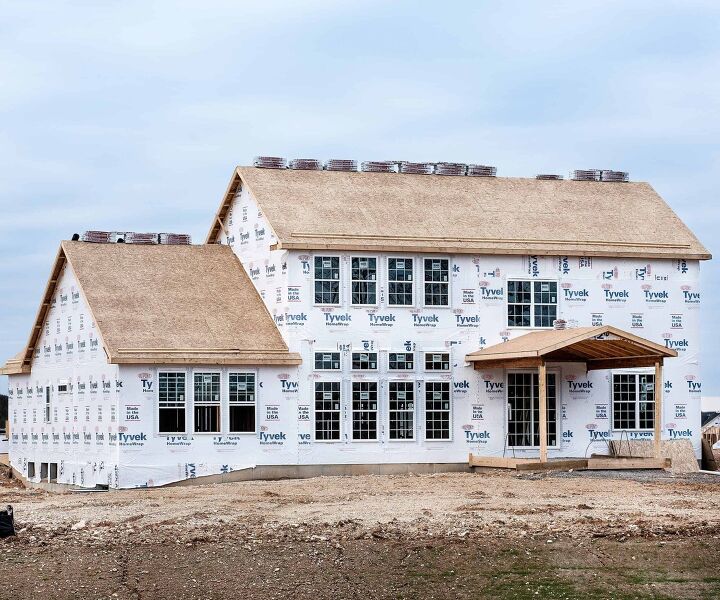Typar Vs. Tyvek: Which House Wrap Offers More Benefits?

When you’re comparing house wrap, you’ll find that most of them have many features in common. House wraps are essential for keeping your home as durable as possible. You’ll want to keep your eyes peeled for things like air-resistance, cold resistance, and UV rating.
Today we’ll be looking at two of the more popular brands head to head: Typar vs. Tyvek. These are both fantastic options for those working on a residential building.
There is no doubt that Typar house wrap wins in durability and quality over Tyvek. Unlike Tyvek, Typar has a 6-month UV exposure rating that is 50% higher than Tyvek. In a water test, Typar delivered better water holdout and breathability. This means it helps prevent moisture. Its durability and tear resistance, which is four times that of Tyvek, makes it two times more effective than average house wrap. According to the manufacturer, Typar’s tear strength is five times that of Tyvek’s.
Below, we’re going to dive deep into what you should look for when shopping for house wraps. There’s a detailed comparison chart that shows where both Typar and Tyvek hit the mark and where they fall short.
What to Look For in House Wraps
House wraps are intended to be a weather-resistant barrier that keeps your walls and sheathing safe. They help with air and moisture infiltration to get the job done. To do this, weather-resistant barriers need to be able to balance air and water resistance with vapor permeability.
Another vital aspect to look for is how strong they are for damage that can occur during construction. Let’s dive into three main features of house wraps to give you a better idea of what you’re looking for.
Water Resistance of House Wraps
One of the primary purposes of a plastic house wrap is to keep water out of the walls. The ICC-ES has three different water-resistance testing standards. When using plastic wrap, only the first two standards are acceptable.
It says:
- Water Ponding is a measure of a house wrap’s resistance to a “pond” of 1-inch water over two hours. CCMC 07102 (Section 6.4.5): Water-Ponding Test.
- Hydrostatic Pressure, the most stringent test, exerts significant pressures on a house wrap sample through a water column. (55 cm or higher)
- AATCC Test Method 127: Water Resistance Hydrostatic Pressure Test.
- The Boat Test for paper and felt wraps is the least stringent standard. It’s extremely sensitive to vapor and humidity transfer. This makes it unreliable for plastic house wraps.
- ASTM D779: Standard Test Method for Water-Resistance of Paper, Paperboard, and Other Sheet Materials by the Dry Indicator Method.
Air Resistance of House Wraps
Another important part of using house wrap is air resistance. This prevents the movement of air across the building envelope. There are a handful of tests to check a plastic wrap for air resistance.
These tests are:
- ASTM E2178: Standard Test Method for Air Permeability of Building Materials (cfm/ft2 @1.57 psf)
- Gurley Hill (TAPPI T-460) (sec/100cc)
- ASTM E1677
- In the comparison chart, you’ll see later on; the Gurley Hill method was used to compare Typar versus Tyvek.
Vapor Permeability of House Wraps
The last thing you should look for in a house wrap is the vapor permeability. This is the amount of vapor transmission that a house wrap lets happen over time. The ASTM E96 tests water vapor permeability on different materials.
The larger the number, the more vapor-porous the material is. It’s important to note that the number can’t be so high that water can get through from the outside into the wall assembly. Experts claim that you want a permeability between 10 and 20.
Comparing Drainage of House Wraps
Drainage is a great way to reduce the moisture infiltration on the wall system from things like rain and snow. Having a high-quality house wrap gives your home an extra drainage system to prevent water build-up.
The Durability of House Wraps
There’s no denying that having a durable house wrap is something every homeowner needs. A construction area can have a lot going on, and things can quickly get damaged.
Durability parameters include UV, cold, and surfactant resistance. It also contains tensile strength.
- ASTM D1117 determines tensile strength or tear resistance.
- UV rating showcases how long a wrap maintains its integrity when exposed to sunlight.
- Cold resistance test standard (AC38 Section 3.3.4: Cold Mandrel Bend Test) shows that the wrap won’t crack at in cold climates
- Surfactant resistance is crucial to the extended durability of a house wrap. Surfactants are contaminants, like soap and oils. These lessen the surface tension of a liquid. Which prevents it from penetrating deeper into the house wrap material.
Typar vs. Tyvek
Below I wrote some of the top benefits for each home wrap product. I hope this gives you a good idea of which one will work best for you. Typar and Tyvek are really similar but do have significant differences that are important to take note of.
Typar Benefits
- Typar building wrap has a six-month UV rating, which is two months longer than Tyvek. This comes in handy if a project is delayed, and the wrap is exposed to the sun.
- Typar is surfactant resistant, making it more durable than Tyvek.
- The wrap’s perm falls right in the recommended rating. This allows the wrap to balance moisture in the wall assembly easily.
- One of the most significant benefits of Typar over Tyvek is the tear strength. Typar is four times stronger than Tyvek’s home wrap.
Tyvek Benefits
- The major benefit of using Tyvek is how thick it is. Depending on which version you get, it’s between four and 20 times thicker than Typar. This makes it more durable, especially in extreme weather conditions.
- There’s also full-thickness protection from air and water on Tyvek. Typar only has a single layer.
- The thickness of Tyvek is much more consistent than Typar.
- Tyvek home wraps dry quicker, reducing the possibility of mold, mildew, and rot.
- Tyvek has a built-in drainage plane to manage excess water. Typar doesn’t have this feature. This could be a crucial benefit for those living in places with a lot of rain or snow.
Comparing the Details
| Wrap Type | AATCC Test Method | Air Resistance | Permeable Rating | Drainage Plane | Cold Resistant | Surfactant Resistant | Tear Strength | UV Rating |
| Tyvek | 250 cm | 2500/sec 100 cc | 56 | yes | yes | no | 30/33 | 4 months |
| Typar | 856 cm | 2500 sec/ 100cc | 7 | no | yes | yes | 30/33 lbs | 6 months |
Related Questions
How long will house wrap last uncovered?
If you have time before you can add siding on, it’s good to know how long house wrap lasts uncovered. It depends on which house wrap you’re using. Most Tyvek wraps can last around four months uncovered. Tyvek commercial wrapping can last up to nine months. Typar can be exposed for up to six months. It’s important not to leave house wrap exposed for an unnecessary amount of time. It’s best to add a long-lasting siding as soon as possible.
Can you put house wrap on backward?
If you install house wrap backward, moisture will still be able to penetrate the outside wall. With that being said, it shouldn’t go through the house wrap. Applying it backward would be having the words TOWARDS the wall. Typically, when installed this way, it acts as traditional plastic sheeting. It could help to layout the sheeting beforehand to ensure that it’s applied the correct way.
Can you put two layers of house wrap on?
You have to look into the specific building code to find out how many layers you can have. Most experts advise having AT LEAST two layers. This is even true when you’re applying it to sheathings that aren’t wood-based.

Kirstin is a passionate writer who loves helping people learn new things when it comes to home improvement. When she's not behind a keyboard, she enjoys DIY projects, crafts, spending time with her pets, and making videos. She hopes that with all she writes, someone is finding a solution to their home improvement needs.
More by Kirstin Harrington













![10 Best Electric Pressure Washers – [2022 Reviews & Guide]](https://cdn-fastly.upgradedhome.com/media/2023/07/31/9070600/10-best-electric-pressure-washers-2022-reviews-guide.jpg?size=350x220)
![10 Best Scroll Saws for 2022 [Ultimate Reviews & Buyer's Guide]](https://cdn-fastly.upgradedhome.com/media/2023/07/31/9070684/10-best-scroll-saws-for-2022-ultimate-reviews-buyer-s-guide.jpg?size=350x220)










![How To Reset A Whirlpool Cabrio Washer [In 5 Easy Steps!]](https://cdn-fastly.upgradedhome.com/media/2023/07/31/9076531/how-to-reset-a-whirlpool-cabrio-washer-in-5-easy-steps.jpg?size=350x220)
![Cost To Drill A Well [Pricing Per Foot & Cost By State]](https://cdn-fastly.upgradedhome.com/media/2023/07/31/9074980/cost-to-drill-a-well-pricing-per-foot-cost-by-state.jpg?size=350x220)
